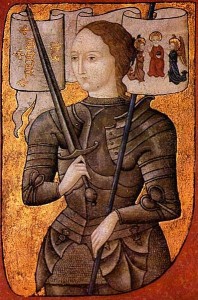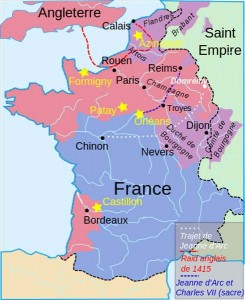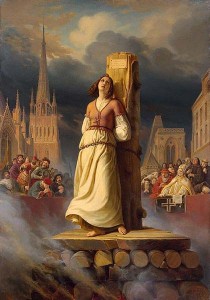| Joan of Arc | |
|---|---|
 |
|
| French Martyr & Saint | |
| Served | 1429-1430 |
| Born | Jan. 6, 1412 Domremy, France |
| Died | May 30, 1431 Rouen, France |
| Nationality | French |
| Canonized | May 16, 1920 |
Joan of Arc was known by many names including The Maid of Orleans, Jehanne La Pucelle, The Maid of Heaven, Jehanne darc, Pucelle d’Orleans, Jeanne d’arc, Joan of Lorraine, and Jeanne of Arc. She did not take her father’s surname, as it was not customary for girls to do so in her village at that time. Her own preference was “Jehanne la Pucelle.” D’arc, or “of Arc”, was not added to her name until some time after her death. The most common name she is called by today is Joan of Arc, or Jeanne d’Arc in French. Though Joan of Arc only lived for 19 years, within this short time she was instrumental in several major changes in France.
Early Life
Although her exact date of birth is unknown, most historians acknowledge it to be January 6, 1412. Her father, Jacques d’Arc, was a farmer, whose ancestors are believed to come from Arc-en-Barrois. Her mother, Isabelle Romee, lived in a village about 7 kilometers from Domremy where Joan was born. When Joan was very young, about three years old, Normandy was invaded by King Henry V of England.
Those who knew Joan as a child described her as good, simple, sweet and pious. She helped her mother with housework and assisted her father in tending his flocks. She was the fourth child born to them, after three sons. Until the age of 12, her life was as ordinary as any other young girl growing up in her village. She loved going to Church and especially believed in going to Confession. She had a charitable nature and would often give up her bed to wayfarers, show kindness to sick people, and engage in prayer for long periods of time.
Though Joan had a peaceful nature, the village in which she lived was subject to violence as it bordered Lorraine and was open to invaders. At least once, she and her family were forced to flee their village when Burgundians raided and ransacked the homes and Church.
France offered little resistance and, as Joan reached adolescence, she became very bothered by this. She testified later that she began receiving visions from God at the age of 12.
Joan of Arc’s Adolescence and the Beginning of her Mission
Revelations from God were given to her in the form of voices from Saint Michael, Saint Catherine, and Saint Margaret. She received her first iteration of divine instruction while working in the garden. It was St. Michael’s voice, accompanied by a blaze of light. Soon afterwards, Saint Catherine’s and Saint Margaret’s voices were also heard. Accepting the visions led to her to take a vow of celibacy and to live her life for God. The three Saints continued to visit her over the course of two years and the visions steadily increased. Eventually, Joan learned that her mission was to deliver France from England and to ensure that the rightful King was crowned on the throne in France.
At the age of 16 or 17, the voices gave her more implicit instructions. She was to go to the Commander of the Dauphin’s forces in Vaucouleurs, Robert de Baudricourt, and convince him that she had been tasked to lead the Dauphin to his crowning. She undertook this journey and was accompanied by her uncle. Understandably, the Commander laughed at her and told her to return home. However, before complying, Joan predicted a serious French defeat and spoke of a French loss at the Battle of the Herrings. The battle was indeed lost and had a devastating effect on the morale not only for those who lived in Orleans, but for all the soldiers in France. When news of the desperate military position of France’s last stronghold Orleans reached Robert de Baudricourt, he agreed to give Joan an escort and allow her to see and speak to the Dauphin.
For her own protection, Joan donned male clothing as the voices of the Saints told her to cut her hair, dress as a man, and arm herself. Baudricourt gave her a horse, and three soldiers to see her through to Charles VII where he was living in the town of Chinon.
Charles VII and Joan of Arc’s Victory
 Charles agreed to see her after two days. He had disguised himself in order to test her, but Joan identified him immediately. Convinced that her mission was authentic, Charles was ready to send her to the troops, but his ministers required more proof before their doubt was dispelled. Joan was sent to Poitiers, where she was questioned and examined by learned theologians for three weeks. After they were convinced her visions were genuine and virtuous, they persuaded Charles that he could make good use of her services. Although she knew no military tactics, she was given a small force of soldiers to lead into battle. In May of 1429, they were able to break through the English line and Joan led her troops to a miraculous victory in Orleans. The siege was raised, and the English fort just outside Orleans was captured.
Charles agreed to see her after two days. He had disguised himself in order to test her, but Joan identified him immediately. Convinced that her mission was authentic, Charles was ready to send her to the troops, but his ministers required more proof before their doubt was dispelled. Joan was sent to Poitiers, where she was questioned and examined by learned theologians for three weeks. After they were convinced her visions were genuine and virtuous, they persuaded Charles that he could make good use of her services. Although she knew no military tactics, she was given a small force of soldiers to lead into battle. In May of 1429, they were able to break through the English line and Joan led her troops to a miraculous victory in Orleans. The siege was raised, and the English fort just outside Orleans was captured.
Next, she and her men attacked and captured Jargeau. Six days later, on June 18 of 1429, they defeated the English in open battle at Patay. As a result, the English forces withdrew to Paris.
Joan original intent was to deliver the Dauphin to Reims so he could be crowned King of France. And, as the road to Reims had been cleared, she believed it was the right time for his coronation. On July 17, 1429, with Joan standing behind him in the Cathedral of Reims, Charles VII was crowned.
After attaining his crown, Charles VII began to disregard Joan’s counsel and advice. Nonetheless, she continued fighting as the English had not been completely driven out of France. Charles VII’s weak attitude and lack of support resulted in a failed attack on Paris. Although Joan was injured during this battle, spring of the following year brought about renewed hostilities, and Joan resolutely hurried back to battle. She went to Compiegne to defend the town against a Burgundian attack. However, her attempted defense failed, and Joan was captured by the Burgundians and imprisoned in a high tower at the castle of Luxembourg.
Joan’s Trial and Execution
 Though she had been an integral part of France’s military success, no effort was ever made to secure her release by King Charles VII and she was ultimately transferred to English hands on November 21, 1430. The Duke who delivered her received a large sum of money and Joan faced charges of sorcery and heresy. The ecclesiastical court presided over by the Bishop of Beauvais, a pro-English clergyman, condemned her as a heretic and a witch. The trial was long and, in the end, Joan’s visions and manner of dress worked against her. The presiding forces condemned her, and it was decided that she would be burned at the stake for heresy.
Though she had been an integral part of France’s military success, no effort was ever made to secure her release by King Charles VII and she was ultimately transferred to English hands on November 21, 1430. The Duke who delivered her received a large sum of money and Joan faced charges of sorcery and heresy. The ecclesiastical court presided over by the Bishop of Beauvais, a pro-English clergyman, condemned her as a heretic and a witch. The trial was long and, in the end, Joan’s visions and manner of dress worked against her. The presiding forces condemned her, and it was decided that she would be burned at the stake for heresy.
Joan was burned in the Rouen marketplace on May 30th of 1431. A cross was held up before her eyes, and she called on the name of Jesus.
Revisiting her Guilt
Twenty-five years later, Pope Callixtus III called a retrial of her case during which she was deemed innocent. She was then hailed as the Savior of France and a martyr. In 1919 Pope Benedict XV canonized her and she became known as Saint Joan of Arc.